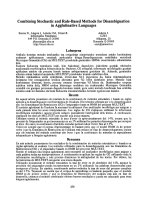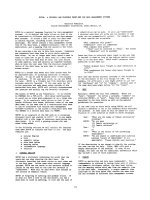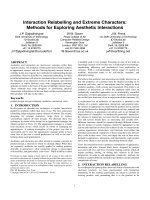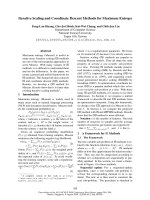Interaction Relabelling and Extreme Characters: Methods for Exploring Aesthetic Interactions ppt
Bạn đang xem bản rút gọn của tài liệu. Xem và tải ngay bản đầy đủ của tài liệu tại đây (689.62 KB, 7 trang )
1
ABSTRACT
Aesthetics and interaction are interwoven concepts, rather than
separate entities. An aesthetics of interaction must consider richness
in appearance, actions, and role. Moving beyond a narrow focus on
usability in this way requires new methods for understanding design
possibilities. Here we describe two: interaction relabelling, in which
possible interactions with a known mechanical device are mapped to
the functions of an electronic device to be designed; and extreme
characters, in which fictional users with exaggerated emotional
attitudes are taken as the basis of design to highlight cultural issues.
These methods may help designers in considering physical
interactions with products on the one hand, and the sociocultural role
their products will take on the other.
Keywords
product design, design techniques, aesthetics, interaction, roles.
1. INTRODUCTION
In this paper we describe two techniques to explore interactions
guided by aesthetics rather than ease of use. The first, interaction
relabelling, helps designers explore richness of actions. The second,
designing for extreme characters, helps them to explore
sociocultural aspects of their designs. We illustrate these two
techniques by means of the design for an appointment manager, the
Masters project of Frens [3]. The appointment manager is a hand-
held electronic device which assists its owner in managing his
appointments. A starting assumption of the project was that to
successfully aid its user, the appointment manager needs to have
some idea of the user’s overall preferences as well as the user’s
feelings about each appointment.
Aesthetics and interaction are often treated as separate concepts in
product design, a situation to which we strongly object. When they
are separated, aesthetics are usually applied to making products
desirable in appearance, while interaction design is preoccupied
with usability, and particularly ‘ease of use’. While usability is often
a laudable goal, it isn't enough. Focusing on ease of use tends to
encourage a narrow view of what ‘use’ is with respect to technology,
emphasising efficiency and productivity over exploration or
curiosity. With a correspondingly narrow range of models for
usability, interaction tends to be self-similar, mundane, and
ultimately boring.
We believe that aesthetics and interaction are tightly interwoven, so
that the aesthetics of a product must be shaped according to its
functions and roles, and its interactions must be judged by their
aesthetic qualities—both sensory and conceptual. This leads to an
aesthetics of interaction, in which the emphasis shifts from an
aesthetically controlled appearance to an aesthetically controlled
interaction, of which appearance is a part. Aesthetics of interaction
moves the focus from ease of use to enjoyment of the experience [4].
A requirement for an aesthetics of interaction is attention to the
richness of a system's appearance, interaction, and potential roles.
By richness in appearance we mean that the product and its controls
distinguish themselves through differentiation in form, material and
texture. Richness in appearance can attract users to act through the
expectation of a beautiful—or aesthetically powerful—interaction.
By richness in interaction, we mean that the engagement between
user and system should have an interesting and variable flow.
Different functions should be operated through different actions,
and the timing of system responses should be appropriate to the
actions and functions involved. By richness in role, we mean that the
systems appearance, interactions, and functions must reflect the
potential sociocultural complexity of those using them [2]. Devices
play a role in their users’ lives, and imply the role of their users:
through its appearance, interaction, and functionality, each product
tells a story about its user and the relationship between them.
Users find enjoyment from a product's combination of appearance,
interaction and roles. Current black boxes, designed for generic
users and with rows and rows of similar looking controls which all
require pushing, turning, or sliding lack richness in all three
dimensions. In order to add appropriate complexity, methods are
needed to explore different interaction possibilities and the potential
complexities of users.
2. INTERACTION RELABELLING
As a technique for opening ideas about rich forms of interaction with
electronic products, we have experimented with interaction
relabelling. In this method, participants are asked to consider an
existing product, and, pretending that it is the product to be
Permission to make digital or hard copies of all or part of this work for
personal or classroom use is granted without fee provided that copies are not
made or distributed for profit or commercial advantage and that copies bear
this notice and the full citation on the first page. To copy otherwise, or
republish, to post on servers or to redistribute to lists, requires prior specific
permission and/or a fee.
DIS ‘00, Brooklyn, New York.
Copyright 2000 ACM 1-58113-219-0/00/0008…$5.00.
Interaction Relabelling and Extreme Characters:
Methods for Exploring Aesthetic Interactions
J.P. Djajadiningrat
Delft University of Technology
ID-StudioLab
Jaffalaan 9
Delft, NL-2628 BX
+31 15 2783775
W.W. Gaver
Royal College of Art
Computer Related Design
Kensington Gore
London, SW7 2EU, UK
+44 20 7590 4296
J.W. Frens
c/o Delft University of Technology
ID-StudioLab
Jaffalaan 9
Delft, NL-2628 BX
+31 15 2783775
2
designed, to tell and act out how it works. The two products need not
be related; in fact, unrelated products may lead to more creative
ideas. Using unrelated products helps designers to part with the
interaction style that is prototypical for the product they are
designing. By forcing a mapping between things with quite different
functionalities, the focus shifts from the functionality to the actual
interaction possibilities. Interaction relabelling also helps in
exploring roles. Different styles of interaction suggest different
things about users and how they value the product.
On a practical level, we have found that mechanical products with
many moving parts work particularly well, since they allow people
to try out actions which are not normally associated with electronic
products. A revolver, for example, has many moving parts (Figure
1). It can be opened, it has cylinder which can rotate and which
accepts bullets, it has a trigger and a hammer. Actions involving
these parts can all be mapped to the functionality of the object to be
designed.
Interaction relabelling works better as group exercise than as an
individual exercise. The competitive element in a group, helps the
participants to overcome their inhibitions in what at first appears to
be a silly exercise. We feel that the actual handling of the object and
trying out actions, rather than just thinking them through, is essential
to this technique.
When Frens relabelled a toy revolver for his appointment manager
project, several ideas for how people might interact with
appointments were highlighted (Figure 2). Appointments were
almost always mapped to bullets, leading to several physical
interactions that might be appropriate to them. These included
loading blanks to plan moments of rest, firing the gun at someone to
make an appointment with that person, rotating the cylinder to scroll
through appointments, and even emptying the bullets from the gun
to cancel all appointments. The revolver, meanwhile, became a
display device for the bullet-events. The participants’ ideas included
putting the gun to your ear to listen to appointments, the gun firing
itself to signal an upcoming appointment with the loudness
expressing its importance, and pointing at a wall and repeatedly
firing the gun to project information about each appointment. Note
that the metaphor need not be consistent. It is the resulting richness
of gestures, not the metaphor that is important. In fact, designs
resulting from relabelling the toygun need not be visually related to
a firearm at all.
The ‘hands-on’ nature of interaction relabelling enables participants
to come up with novel ideas about interaction which are different
from those which emerge from market research, literature studies,
traditional brainstorming techniques or sketching. A different choice
of object highlights different interaction possibilities. Relabelling a
simple object, such as a stapler, forces designers to think in equally
simple actions for the product to be designed, while choosing a
complex object, such as a Swiss Army knife, allows them to think of
a more gadget-like product. Through the connotations of the object
that is relabelled, the technique also makes designers aware of the
socio-cultural role their products can play. A PDA which draws
upon interaction with a simple stapler suggests its owner has a very
different attitude towards appointments than one whose actions
resemble a precise and complex Swiss Army knife.
3. DESIGN FOR EXTREME CHARACTERS
Products are often designed for a particular target group. A well-
known approach is to write a scenario for a prototypical character
from this target group. For example, when designing a PDA, we may
write a scenario around Jack, who is a management consultant. The
scenario may be very detailed in terms of lifestyle. Jack likes
wearing Hugo Boss suits and driving his BMW. However, from an
emotional point of view Jack seems shallow and completely out of
touch with the real world—apart from work. Jack is always keen to
go to his next appointment, he is never tired, never bored. He does
not seem to have any bad character traits either: he is nice and
serious. This is reflected in the roles the product supports. The
appearance of and the interaction with the resulting PDA tell the
story of Jack and his relationship with the product. While the user
does not know about the scenario, he is still confronted with Jack’s
values since the product’s role supports Jack. Designing for
prototypical characters such as Jack ignores the full spectrum of
human emotions, it only addresses those recognized as socially or
culturally desirable.
Designing for extreme characters is a technique which tries to steer
away from the usual designing for a prototypical character from a
target group. In fact, it takes the opposite approach. Instead of
Figure 1. The toy revolver
Figure 2. Interaction relabelling with the toy revolver
3
designing for characters that are emotionally shallow, we design for
characters that have exaggerated emotional attitudes. By taking
characters that are extremes, character traits can be exposed which,
though common, remain hidden because they are antisocial or in
conflict with a person’s status.
In his project, Frens designed for three extreme characters: a
drugsdealer, the Pope and a polyandrous twenty-year old. The
characters were not only described in words, but also visualized in
the form of collages showing a day in their lives. Through role-
playing with fellow students, the three characters came further alive
[1]. This development of the character through visuals and role
playing is important as it draws links between the character and
appearance, actions and role, which are difficult to anticipate or
express using words alone. Each of the three characters has a unique
attitude towards appointments. We will describe the characters, then
the concepts which resulted, and discuss in which way the insights
are valuable for mainstream PDAs.
3.1 The drugsdealer
Profile—
The drugsdealer is a powerful person who manages rather
than commits crimes (Figure 3). To cover up his illegal dealings, he
is also involved in legal activities. The drugsdealer is highly aware
of his place in the drugs trade hierarchy. Above him in rank are the
big players from whom he buys, below him are the drugs runners to
whom he sells. It is a rough world, and in response the drugsdealer
has adopted an opportunistic attitude in his pursuit of money and
power.
Attitude towards appointments.—
The drugsdealer has two
agendas, one legal and one illegal. The information about his illegal
activities is very sensitive. It should not fall into the wrong hands, be
it ‘colleagues’ or the police. Clearly, he is very careful with whom
he makes appointments and where. Meeting places are specified by
their characteristics. Roads which will allow a quick get-away and
buildings which will provide cover are important considerations.
The drugsdealer does not plan very far ahead. Dealers come and go;
the scene may look very different next week. The drugsdealer is
ambivalent about exposing his appointments. On the one hand, they
contain sensitive information. On the other, exposing them means
enforcing his position in the hierarchy, a kind of powerplay which
draws new trade. In his appointments he needs to express his respect
for the big players and his superiority over the smaller dealers to
whom he sells.
3.2 The Pope
Profile—
The Pope is a person who is very powerful in theory,
though in many ways his actions and emotions are prescribed
(Figure 4). He is very much restricted by protocol. Frens' fictitious
Pope saw his formal appointments as tedious and valued his leisure
time very highly. He enjoyed a stroll in the Vatican gardens and the
conversations with his favourite nun. When it came to his formal
tasks, the Pope needed a little encouragement from time to time. The
Pope knew that he could get in trouble if he did not fulfil his formal
duties. In a sense, he viewed his negotiations with the appointment
manager to gain leisure time as a kind of game.
Attitude towards appointments—
The Pope’s life is full of
compulsory, repeating appointments. In the time slots that remain,
the Pope likes to enter as many personal appointments as possible,
so that he cannot be hassled for other tasks. While he needs to share
the information in his agenda with others who organize his public
life, there are some appointments which he would rather not disclose
to others.
3.3 Hedonistic, polyandrous twenty-year old
Profile—
This is a fun-loving woman who has a great many social
contacts, including several boyfriends (Figure 5). She has got a
normal day job as a school teacher. But what she looks forward to
all day is her free time after work and during the weekends. Full of
Figure 3. The drugsdealer
Figure 4. The fictitious Pope
4
energy, she is always looking to have a good time. Going out can be
nerve-wrecking though, as she needs to be careful about boyfriends
meeting each other. She needs people around her, as she is not very
good at amusing herself on her own.
Attitude towards appointments—
For the twenty-year old, part of
the fun is juggling appointments in such a way that her boyfriends
do not learn of each others’ existence. When asked out by more than
one boyfriend, she wonders what she feels like doing that evening
and which boyfriend fits that idea best.
4. CONCEPTS
4.1 The drugsdealer’s rings
The appointment manager for the drugsdealer consists of a set of
rings and a pouch in which the rings can be stored when not in use
(Figure 6). Each ring that the drugsdealer wears stands for an
appointment (Figure 7). Since the drugsdealer plans only one day
ahead, the number of rings which fits on both hands is sufficient for
one day. Which finger a ring is on determines the importance of the
appointment: the more towards the little finger, the more trivial. The
rings are available in different forms and materials so that when the
drugsdealer makes an appointment with a person, he can choose a
ring matching that person’s place in the trade hierarchy. Rings can
consist of two parts so that when a task is delegated, one part is given
away, with completion being signalled by the parts being reunited.
A sleeve-like ring which prevents a finger from bending can
function as a physical reminder of an urgent appointment.
Embedded electronics make each ring aware of its value and the
appointment’s time and place. Finally, abstract patterns of light
emitted by a ring can signal conflicting appointments as the
drugsdealer tries to fit an appointment into his schedule.
The design of the drugsdealer’s rings reflects his ambivalent attitude
towards exposing his appointments. On the one hand, he shows of
how busy he is, enforcing his position. On the other, he does not
want to disclose any details about his appointments. The rings form
a kind of augmented ‘knot-in-a-handkerchief’ appointment
manager.
4.2 The Pope’s stubborn pen
The Pope uses a digital version of pen, inkwells and paper (Figure
8). Seemingly conventional, these objects blend in with the rest of
the Vatican’s interior. Differently shaped inkwells represent various
emotions (Figure 9). Dipping the pen in an inkwell causes it to be
charged with a certain emotion. The pen recognizes the Pope’s
handwriting and tracks how much of each digital ink is used. When
the ratio of leisure time to imposed appointments drops too low, the
digital pen simply stops writing with leisure-related inks. To be able
to collect more leisure time, the Pope has no choice but to complete
more formal appointments.
Figure 5. The hedonistic, polyandrous twenty-year old
Figure 6. Premodels for the rings for the drugsdealer
Figure 7. The rings for the drugsdealer
5
The design of the stubborn pen reflects a tension between autonomy
and responsibility for the Pope. On the one hand, the stubborn pen
comes across as a dictator, reifying his own good intentions as well
as outside requests and insisting that he respect these demands. On
the other hand, a strong hand in his life is exactly what the Pope
needs; it helps the Pope stay out of trouble. Taking the implicit
conflict to humorous levels through the stubborn pen, Frens
highlighted an issue that seems true for all appointments managers.
4.3 The twenty-year old’s appointment fan
The appointment manager of the polyandrous woman makes use of
five circular screens which fold up in a fan-like manner. To support
the woman in her polyandrous behaviour, the fan is usable in two
modes. In the first mode, which is called public mode, all the screens
are folded in and only the top screen is visible. This is the mode
which she can use without worries while amongst other people. If
necessary she can take a quick peek at one of the other screens. In
the second mode, called private mode, the screens are folded out, In
this mode the woman can check upon sensitive information.
Through the playful positioning of the screens, the woman can rate
and compare her boyfriends on a fun-profile with issues such as
dining, shopping, partying, sex etc.
The appointment fan fits the twenty-year old’s attitudes. It helps her
maintain her hedonistic lifestyle by remembering attributes of
boyfriends and allowing her to adjust these through an
uncomplicated, playful interface. The dual modes allow her to use
the device in public without disclosing the details of her agenda,
satisfying her special need for privacy.
5. EVALUATING THE CONCEPTS
The rings for the drugsdealer opened interesting possibilities for
actions, such as linking importance to placement and delegating
through sharing. However, the aesthetics of the rings for the
drugsdealer are rather stereotypical. The design is directly based on
our notion of drugsdealers wearing jewellery as they are portrayed
in films. Similarly, the role the rings support is that of a stereotypical
drugsdealer. This stereotypicality of both aesthetics and role makes
it difficult to apply the concept to the real world without the
drugsdealer shining through.
The Pope turned out to be a difficult character as his remoteness
from the world made him difficult to identify with. As it did not
seem appropriate to equip the Pope with a high-tech gadget-like
appointment manager, the concept stayed rather close to the pen-
paper metaphor. As a result, the concept offers few new insights in
terms of appearance and actions. An interesting aspect of the Pope’s
appointment manager is that it forces its owner to balance the types
of appointments. While at first this design may come across as a
‘dictator’, it can also be interpreted as helpful for those who tend to
leave their professional tasks till the last moment.
Frens chose to develop the concept for the twenty-year old’s
appointment fan further. Designs for the twenty-year old were the
least stereotypical, both in appearance and in interaction. Frens
translated the frivolity of the character into playfulness in
interaction. The multiple blades invite ranking of boyfriends and the
interface is completely pictorially oriented, using pictures taken
Figure 8. The stubborn pen with various inkwells
Figure 9. Premodels for the inkwells
Figure 10. A quick peek at a screen in public mode (left) and all
screens folded out in private mode (right).
Figure 11. Premodels of the appointment fan
6
with an integrated camera to describe the person, location and
subject of an appointment. While the twenty-year old may come
across as a frivolous character, some ideas for the appointment fan
can easily be introduced to more serious applications. For example,
by replacing ‘boyfriends’ with ‘business contacts’, moving the
blades could become a way of judging business priorities. Likewise,
for a freelancer, public mode may become a way of shielding ties
with one client while visiting another.
6. CONCLUSIONS
Interaction relabelling helps designers break loose from existing
notions of interaction. For PDAs, whose interactions have got stuck
in graphical user interfaces scaled-down from desktop monitor size,
the fresh look provided by interaction relabelling turned out to be
quite useful. The technique exposes how poor most electronic
products are in terms of actions when compared to mechanical
products. Apart from widening the designer’s view on possible
actions, the technique also helps to explore how the actions
influence the role a product supports. An appointment manager
offers a very different view of its owner and their relationship when
it is a gun than a traditional PDA; the kind of emotional relationship
the user has with appointments is different. Although interaction
relabelling is not directly concerned with appearance, any changes
in actions will force a rethink of the product’s aesthetics.
Designing for extreme characters was useful for this project in
highlighting issues such as secrecy, status, and autonomy not
normally emphasized by appointment managers. While they were
discussed as separate concepts, for Frens they also had synergistic
strength, with aspects of one extreme character influencing the
other. We hope to have illustrated that designing for the polyandrous
woman allowed Frens to break away from existing notions of PDA
aesthetics and PDA interaction. In fact, the appointment fan is more
likely to fit the twenty-year old in terms of aesthetics, functionality,
and cultural signification than the PDA. This is the central aspect of
designing for extreme characters: the extremes make one realize that
the way things are is not necessarily the only way. They allow one
to think of the richness of aesthetics, interactions and roles that
electronic products could offer next to the narrow, existing ones.
During the project we have become aware of the importance of the
choice of character. Two of the three extreme characters that we
used were stereotypical, and to at least one reviewer offensively so.
The jewellery wearing drugsdealer and the attractive polyandrous
woman touch upon sensitive issues such as race and gender, and the
clichéd images used to portray them exacerbate this problem.
Moreover, using the Pope as a third character runs the risk of causing
offence to others (even without our mentioning his fictional
girlfriend). We recognise the problems of publishing such
descriptions here, and apologise for any offence caused by doing so.
It should be remembered, however, that these characters were
chosen as part of an in-house design process, as a way of uncovering
more generally applicable issues, and we are publishing them here
to illustrate the process without suggesting that they in any way
represent real users or that they would be carried through in the
development of designs. Instead, their power was in allowing the
designer to draw inspiration from the film, publishing and fashion
industries, which also work with these stereotypes. In future
projects, we plan to explore extreme characters that are not so
clichéd, such as a professor who does drugs or an introvert
drugsdealer. While such characters may be more difficult to design
for as they are seldom represented in mainstream media, they may
well lead to more complex and interesting ideas.
The two techniques described in this article aid designers in
achieving richness on the actions and role levels. Interaction
relabelling tries to open up the spectrum of actions that can be used.
It makes us aware of the richness of actions present in mechanical
artifacts, which is absent in the controls of electronic products. It
also helps to explore how the interaction influences the relationship
between user and product. Designing for extreme characters tries to
expose those emotions and character traits which remain hidden in
scenarios for supposedly real-life characters because they are
incorrect or embarrassing. The technique reminds us that in order to
design humane products, these ‘undesirable’ emotions and character
traits cannot be disregarded as they are, after all, what makes us
human.
7. REFERENCES
[1] Burns, C., Dishman, E., Verplank, W., & Lassiter, B.
(1994). Actors, hairdos & videotape—Informance
Design. In CHI'94 Conference Companion. New York:
ACM Press.
Figure 12. The final model folded in (public mode)
Figure 13. The final model folded out (private mode)
7
[2] Dunne, A. (1999).
Hertzian Tales: electronic products,
aesthetic experience and critical design
. London: RCA
CRD Research publications.
[3] Frens, J.W. (1999).
Design of a portable appointment
manager which considers content and emotional value
of appointments
. Master’s thesis. Delft University of
Technology.
[4] Overbeeke, C.J., Djajadiningrat, J.P., Wensveen, S.A.G.,
& Hummels, C.C.M. (1999).
Experiential and
Respectful
. Proceedings of the International Conference
‘Useful and Critical’. UIAH, Helsinki.









